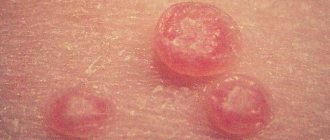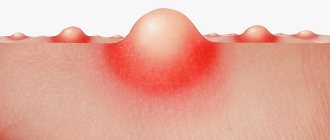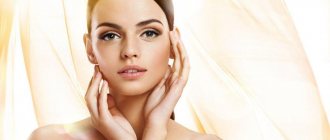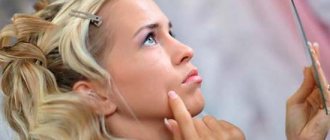Rosacea is one of the skin diseases. Typically, rosacea on the face occurs in women. Modern advances in the field of dermatology make it possible to stop this disease. Many patients worry and ask: “Can rosacea be cured?” It should be borne in mind that over time, this disease usually progresses, gradually moving into the most severe stages, which are difficult to cure. This happens with strong vasodilation, when rhinophyma appears. Therefore, if you experience symptoms indicating the occurrence of rosacea, you should contact a dermatologist.
If diagnosed in a timely manner, you can protect your skin from further manifestations of the disease. In the initial stage, the tested remedies give a positive effect.
You may also be interested in articles about rosacea:
- Rosacea: what it is and how to treat it;
- How to treat rosacea yourself;
Rosacea refers to a chronic skin disease that is characterized by redness, bumps, and rashes. Fifty percent of cases affect the eyes.
The exact cause of rosacea is not yet known. Doctors believe that it may be based on the strong sensitivity of the blood vessels. As a result, patients experience dilatation of the skin arteries under any irritants. Whereas healthy people do not react to the same influences. Recently, scientists believed that rosacea occurs due to the presence of a mite called demodex, which lives in the sebaceous glands of the follicles.
Previously, it was believed that the mite, which causes demodicosis, contributed to the appearance of the disease. However, this theory has been refuted, since demodex also occurs in healthy people. Therefore, today it is not considered the main factor in the progression of rosacea. It becomes a consequence, and not at all the cause, of the skin changes that occur.
Signs of illness appearing
The appearance of rosacea can be judged by the following signs:
- persistent facial redness. It usually appears in the area of the nose, forehead, chin, and cheeks. This type of inflammation can spread to the chest or back;
- the rash first appears as small pink bumps, eventually turning into pustules;
- redness and thickening. This happens in later stages;
- the vessels dilate, the vascular network appears;
- the occurrence of rhinophyma or thickening of the skin in the nose area;
- eye damage often occurs. In this case, pain in the eyes and a sensation of a foreign body may appear.
Complex algorithms are used to determine the severity of the disease. You need to keep in mind that rosacea will not go away on its own, it may only disappear for a while. Therefore, when symptoms appear, you should prevent the disease from developing, but begin treatment and stop it in a timely manner.
Cosmetics for rosacea
During treatment for rosacea, you should avoid using decorative cosmetics. But if you want to disguise rosacea and inflammation, you can use cosmetics that meet the following requirements:
- creams are allowed only on an oil-free basis, not containing talc or fragrance;
- Sun protection is required - at least SPF 30;
- Green primers are used to neutralize redness. It is better to choose a foundation with a yellowish tint;
- all other cosmetics - eyeliner, lipstick, powder, eye shadow - must be labeled “for hypersensitive skin.”
Before using any product during treatment, even the usual one, it is necessary to conduct a skin test.
Risk factors
People of any gender from thirty to fifty years old can get rosacea. Northern peoples with fair skin and blond hair are more predisposed.
The main risk factors include people with diseases:
- Gastrointestinal tract,
- gastritis;
- endocrine system;
- disorders of the immune system;
- genetic predisposition.
Exacerbation of rosacea occurs during windy weather, cold, heat, exposure to sunlight, consumption of hot food and drink, and spicy dishes.
Primary signs of rosacea
- Redness of the face (sharp flush). People with rosacea often experience redness in their faces. This happens for any reason, at the slightest excitement or exposure to external factors. Facial flushing may come and go, and is often the earliest sign of the disorder.
- Constant redness. Persistent facial redness is the most common individual symptom of rosacea and can resemble flushing or a sunburn that does not go away.
- Lumps/swellings/bumps and pimples. Small red solid bumps or pus-filled pimples often develop. Although they may resemble acne, there are no blackheads and there may be a burning or chilling sensation.
- Visible blood vessels. In many people with rosacea, small blood vessels become visible on the skin.
Treatment methods used
Treating rosacea is not that easy. This may take several months. The main forms of rosacea are treated with antibiotics. The therapy uses quite complex schemes that have been tested and work effectively. In the later stages of treatment, electrocoagulation and other modern methods, including laser, are used. The course of treatment procedures is selected depending on the stage and form of the disease. Rosacea is treatable, but not quickly. Under the supervision of doctors, the disease is controlled, symptoms are eliminated, and the skin is restored.
Talking with those who have cured rosacea, you can find out how difficult it was to achieve the goal. There is no established treatment regimen to cure this complex disease. The mechanism of disease progression is directly related to the degree of vascular sensitivity in a person. In the worst case, thickening of the dermis and detachment of the epithelium occurs.
Everyone who suffers from this disease is concerned with the question: “How to cure rosacea? " There is no clear answer. Each sick person is thoroughly examined. It is important to establish the possible cause of the disease. Next, treatment is prescribed, and the disease is controlled during the procedures.
If you manage to find out about rosacea at the initial stage of the disease, then after several months you can get rid of the disease. In this case, you have to undergo complex therapy and go to an appointment with an ophthalmologist, gynecologist, gastroenterologist, endocrinologist.
When purulent rashes appear, the doctor prescribes gels and ointments with antibiotics. However, this treatment may not help. Then you have to use medications such as oxacycline, metacycline. If papular rosacea appears on the skin of the face, then ftivazin is prescribed. It is considered quite effective.
Currently, treatment methods are used to eliminate the signs of the disease. This improves the functioning of blood vessels. Using laser technology, it is possible to remove rough skin on the face. During the procedure, the pustules are dried. Thanks to pulsed light:
- redness disappears;
- blood vessels become invisible;
- skin color improves.
A complex such as Ruboril improves blood flow, strengthens the walls of blood vessels, and relieves swelling.
Results
Facial rosacea is a disease that can be overcome with the right treatment, which must be carried out over a long period of time. Instant healing will not happen, and good results can only be achieved after months of work. In each case, the treatment of rosacea is a multi-step process, and in order to move to the next step, it is necessary to evaluate the existing achievements. It should be remembered that in almost all cases of rosacea, the connective tissue of the affected area is vulnerable, so steps must be taken to maintain it in a healthy state. Therefore, changes in diet and lifestyle may be required to maintain ongoing control of the disease.
Based on materials from https://www.beautymagonline.com/
Tags: skin diseases
Market Analytics
- Black Lives Matter movement: reaction and consequences for the beauty industry
- COVID-19 is changing the rules of the game in the cosmetics market
- Beauty of the future: cosmetic innovations 2020
Convenient search for beauty salons on our website
Beauty salons in Moscow Beauty salons in St. Petersburg Beauty salons in Ekaterinburg Beauty salons in Novosibirsk
Latest blog posts on our website
- Naturecream / Apricot kernel oil for face
- Naturecream / MATRIXYL3000 - the best skin elasticity stimulator
- Naturecream / SPF in Natural Oils
- Naturecream / Geranium (Pelargonium) oil for skin health and beauty
- Prostye-sovety / Save on a beauty salon: procedures that can be done at home
- Naturecream / Growth Factor - brings back youth?
- Oksana-Lezina / 3 effective abdominal exercises from a fitness instructor for beginners
- Prostye-sovety / Making perfect curls at home
- Prostye-sovety / Which hair removal method to choose
- Naturecream / Wrinkles Puppets
Latest forum topics on our website
- Natalya / How to properly make a gelatin mask?
- Mrs._Smith / Badly sunburned! What to do?((
- Ice / Is it necessary to combine fitness classes with a diet?
- Antonova / What can be used for hair loss?
- Radio operatorKat / Who was on a protein diet?
Other articles in this section
| Dehydration of the epidermis Dehydration (dehydration) is the cause of many skin diseases, but is not a disease in itself. As a result, diagnosing dehydration is a particular challenge. |
| Laser removal of papillomas Laser removal of papillomas is an absolutely safe and effective way to get rid of skin lesions located on any area of the skin, including the face. |
| Daily breast care Since breasts are made up of soft connective tissue, fat cells, milk ducts and glands and do not contain muscle, it is impossible to increase their size through exercise. There are also no complexes for breast reduction, which is especially important for women with a large bust. However, if you are overweight, you can reduce your breast size somewhat through diet and regular exercise to lose weight. |
| Digital and manual dermatoscopy: what it is, how it is performed, features of the procedure Dermoscopy is a modern method for diagnosing neoplasms and melanomas on the skin. It is carried out without surgical intervention, the integrity of the skin is not compromised. The doctor uses a special device, a dermatoscope. Thanks to a magnifying glass, it is possible to examine the deeper layers of the epidermis. The doctor visually assesses the changes occurring and can identify tumors at an early stage, when there are no obvious symptoms yet. Experts advise carrying out the procedure annually as a preventive measure. |
| Caring for the skin around the eyes The eyes are the first thing we notice in the person we first meet. We look people in the eyes when we talk to them. They say that the eyes are the mirror of the soul. We rub them when we are tired, we get wet when we cry. They give us away when we are tired, happy or sad. We ignore them until something goes wrong. And then we begin to lose our vision, we notice that it becomes more and more difficult to apply makeup, and our eyes no longer look so beautiful. |
| What is the difference between cellulite and fat? Is there a difference between cellulite and fat? Yes, there is a difference, despite the fact that many argue with it. Under a microscope, fat and cellulite look the same, but that's where the similarities end. Have you ever wondered what fat is? When a person “gets fat”—that is, gains weight—what is actually happening inside his body? What are “fat cells” and how do they work? In this article we will introduce you to the world of fat cells. We explore where fat cells are located, how they store fat – and how they get rid of it! |
| Psoriasis: causes, symptoms, classification, stages and severity Psoriasis is a chronic non-infectious recurrent disease of autoimmune origin, affecting mostly the skin and its appendages, and to a lesser extent the joints. Both men and women are equally susceptible to the disease. More often the disease manifests itself after 30 years, there have been cases of congenital psoriasis. The disease occurs with remissions of several months or several years, exacerbations often occur in the autumn-winter period. |
| How to tan properly in the sun: get an even tan by following 7 rules In the summer, you want to get an even and beautiful tan that lasts a long time, without any peeling or blistering. In this sense, those with dark skin are luckier; they tan quickly and do not experience discomfort, especially if they use sunscreen and after-sun products. But how to tan properly in the sun and sea, how to get a beautiful and even tan for those with fair skin? We will talk about this in this article. |
| Skin and hormones All these torments from acne in adolescence, itching, premenstrual rashes, skin problems during pregnancy and changes that occur with it after menopause... What does this have in common? Sex hormones. |
| The effect of pregnancy on the skin and skin care during pregnancy There is not a single organ or cell in a woman’s body that is not affected by pregnancy. And the skin is one of the first to be affected by this, because it is an organ with many functions that is closely connected with all systems of the body. |
Traditional medicine
If you set a goal to cure rosacea forever, you should also use traditional medicine. In this case, treatment is carried out with various masks and lotions that have disinfectant and anti-inflammatory properties. It is necessary to wipe off inflammation on the skin with similar products.
For example, cold lotions made from a collection of string, parsley, yarrow, chamomile, etc. are effective for relieving swelling and redness. An excellent remedy is a room temperature mask made from rose hips. You need to put gauze in this decoction, apply it to your face and keep it for twenty minutes, changing the gauze five times.
Collections from horsetail, nettle, and burdock are considered useful. This herbal composition should be drunk half a glass 4 times a day.
How is the treatment carried out?
With the help of Troxevasin, you can improve the condition of the vascular walls.
Treatment of rosacea consists of normalizing the condition of the capillaries. To improve their elasticity and eliminate fragility, Troxevasin is used. To eliminate toxins, preparations with vitamin E are used. To strengthen the walls of the capillaries, Ascorutin is prescribed. Thanks to drugs with adrenaline, the appearance of the vascular network is reduced. To improve the condition of the skin, the following procedures are used:
- ultrasonic cleaning;
- galvanization;
- enzyme and chemical peeling;
- gas-liquid dermabrasion.
Based on the cause of the disease, antiparasitic and antibacterial agents are used. Drugs like Spregal and Metronidazole are often prescribed. Antibiotics of the tetracycline group are mandatory. As well as ointments and creams that contain an antiseptic. If you have rosacea, it is important to follow your diet and drinking regimen.
Demodicosis
As noted above, demodicosis is a disease associated with ticks. Is it possible to cure demodecos? Conducted studies prove that the tick is a conditional pathogen, which is considered a normal condition and not a pathology. If there is a certain number of mites per skin cell, namely from one to three individuals, then this is the norm for a person and there is no need to get rid of it.
A small amount of demodex is not able to affect the skin in the deep layers. Therefore, such parasites cannot harm the skin and hair. Only in cases of active tick reproduction should treatment be carried out. A good environment for the parasite to reproduce is created under constant stress and disruptions in the immune system. Treatment requires long-term therapy, in which it is necessary to destroy the tick and increase the body's protective functions. Demodicosis is a direct consequence of some internal disease. In such cases, the patient is prescribed a complex of drugs to get rid of demodicosis.
conclusions
- Rosacea is an inflammatory skin disease of unknown origin. Today, only the factors that provoke and contribute to the development of the disease are known.
- With rosacea, as with rosacea, you need to use medicinal, not cosmetic creams or ointments with a general inflammatory effect, rosacea cream and special products.
- Medications are prescribed by a dermatologist after consultation with a gastroenterologist and neurologist. The course includes not only creams, but also tablets and physiological procedures.
- It is very important to prevent relapses after finishing treatment. For this purpose, the prescribed ointments are periodically reused for preventive purposes.
Causes and mechanism of development
Although the nature of the disease is not precisely determined, it has previously been hypothesized that it appears in meat-eaters who consume animal fats. However, during research it turned out that the disease appears not only in people who eat meat in their diet, but also in vegetarians. Frequent use of corticosteroid ointments is the main cause of rosacea. In this case, a phenomenon called “steroid” skin occurs, which leads to elastosis (moderate atrophy of the skin).
Occurring as abnormal redness of the skin in the central areas of the face, sometimes on the neck, décolleté, rosacea develops under the influence of the following factors:
- blood vessels overflowing against the background of heat or cold;
- ultraviolet radiation;
- genetic predisposition;
- drinking alcohol, hot drinks;
- severe emotional stress;
- depression;
- food that includes fatty, sweet, spicy foods;
- excess spices in food;
- diseases of the small intestine;
- endocrine system problems;
- presence of demodicosis;
- immune disorders;
- allergic reactions to cosmetics.
Diagnostic methods
To make a diagnosis, the patient may be sent to a laboratory to donate blood for hormones.
An experienced dermatologist, upon examination and the presence of symptoms of steroid rosacea, will immediately establish an accurate diagnosis. The clinical picture is determined using tests such as bacterioscopic, bacteriological, histological, and sampling for demodicosis. An antibiogram is performed to determine the sensitivity of microflora to drugs. Concomitant diseases that affect the treatment of rosacea are diagnosed using x-rays of the gastrointestinal tract, immunological analysis, and blood tests for hormones.
Diagnosis of rosacea
Erythematous rosacea has a fairly characteristic clinical picture, so a doctor can sometimes make a diagnosis based only on the patient’s appearance (especially if the disease is advanced and rosacea forms on the nose).
Concomitant diseases of the digestive system and the detection of Demodex mites will also speak in favor of the disease.
How does it manifest?
At first, the disease may manifest itself as hyperemia of the skin and light vascular network.
Rosacea on the face appears in the form of red spots in the T-zone of the face (forehead, nose, chin). Affecting the middle-aged population, it occurs predominantly in women, although cases of the disease in men and sometimes children have become more frequent. As the disease develops, it goes through 3 main stages of development, from the initial to the critical point of skin damage.
| Course of the disease, stages | Main manifestations |
| I | Hyperemia |
| Persistent dilatation of small blood vessels in the skin | |
| Tingling and burning | |
| Swelling in the central area of the face | |
| Peeling | |
| II | Persistent erythema |
| Presence of inflammatory papules, pustules | |
| Burning | |
| Redness over large areas of the face, sometimes the scalp | |
| Increase in rashes | |
| After the papules heal, scars remain | |
| III | Presence of extensive furuncle-like nodes |
| Lumps and swelling | |
| Enlarged pores | |
| Lumpiness of the skin | |
| Tumor-like change in the nose | |
| Telangiectasia (spider veins) |
Treatment of skin rosacea. What can I do to prevent symptoms from returning?
Diagnosis and treatment of skin rosacea is not difficult for a cosmetologist if a person notices changes in a timely manner and seeks help from a specialist. But who among us likes to “go to the doctors” when there are no serious health problems? It's much easier to handle everything on your own.
And what's the result? A constantly red face, “spiders” of dilated blood vessels, acne, a pronounced reaction to changes in temperature and air humidity are gradually becoming a common condition. Any skin symptoms are assessed and interpreted separately and treated separately: moisturizers to reduce dry skin and reduce its sensitivity to external influences, alcohol-containing acne lotion, valerian tablets to reduce emotional reactions that cause flushing of the face.
The number of jars, bottles, tubes on the dressing table or on the shelf in the bathroom increases, but the problem is not solved, on the contrary, it only gets worse. And all because it’s not about a “bouquet” of separate skin problems, but about one single disease called rosacea with such different manifestations. Uncontrolled use of cosmetics and medications only aggravates the condition. Like any other skin disease, rosacea requires comprehensive treatment. Let's talk about this.
What is rosacea?
Rosacea is a chronic dermatological disease, which is characterized by persistent redness of the central part of the face, the formation of tubercles, pustules and other elements of the rash, spider veins and mesh. The second name of the disease is rosacea, although elements of a rash are not at all a necessary symptom of a pathological process that has engulfed the skin. Frequent relapses of the disease after treatment of skin rosacea against the background of unfavorable external influences are typical, so you will have to be especially careful to care for your skin during the period of achieved remission.
Diagnosis and treatment of skin diseases such as rosacea are the responsibility of a dermatologist. In case of mild to moderate severity of the disease, you can turn to a cosmetologist for help, who will prescribe the necessary hardware procedures, adjust home care, and recommend medications for topical use.
Symptoms
Most often, rosacea is diagnosed in people 30-50 years old with fair skin, which is practically not protected from the effects of ultraviolet rays by melanin. At the same time, the patient’s dark or dark skin does not exclude the diagnosis of rosacea.
Depending on the prevailing external manifestations, four main forms of the disease are distinguished:
- Erythematous-telangiectatic. Its main manifestations are erythema and telangiectasia. The area of redness of the skin includes the wings of the nose and cheeks. Many patients note a feeling of a rush of blood to the face with a local increase in skin temperature and a burning sensation. Subjective sensations often arise under the influence of external factors (dry indoor air, cold when going outside from heat, sunlight, etc.).
- Papulopustular. In addition to erythema, papules and pustules appear on the skin. Elements of the rash are constantly present on the skin. During the period of exacerbation, their number increases significantly.
- Phymatous. This form is characterized by the formation of massive loose growths in the area of the nose, eyelids, and forehead against the background of persistent redness of the face. Develops predominantly in men.
- Ocular. It differs from the previous 3 forms in that it mainly affects the skin around the eyes. Often, even before the development of erythema, the patient manages to get sick several times with keratitis, blepharitis and other ophthalmological diseases. Dilated blood vessels in the ocular form of rosacea can develop not only on the skin, but also on the eyeball.
The first two forms are the most common and can be corrected quite easily in a cosmetology clinic. Different forms of the disease do not transform into each other, since they are not successive stages of development of the pathological process. They are united by the presence of erythema, against which secondary symptoms appear. This means that, for example, a patient with the ocular form will never have phimosis or characteristic papules.
The redness of the face does not immediately become persistent. Angioneurotic disorders increase gradually. At first, erythema appears in response to washing, prolonged exposure to the open air in inappropriate weather, or the use of inappropriate cosmetics. Then, over the course of several years, the duration of the episodes of redness increases, the intensity of the skin color changes from light pink to red, sometimes bluish.
Against the background of persistent redness, dilated vessels do not become noticeable immediately. Telangiectasias appear gradually as the diameter of the arterioles involved in the pathological process progressively increases. Blood stasis, increased permeability of the vascular wall for fluid leads to the appearance of persistent facial edema.
Causes
Rosacea is a polyetiological disease. The impetus for its development, as a rule, is a combination of several external and internal damaging factors that affect a person for a long time. Once the disease has developed, there is no need to talk about the causes. However, one can never exclude the possibility of a relapse, which can be provoked by the same influences.
The main reasons for the development of rosacea include:
- Climatic factors. Of primary importance are wind, extreme temperatures (heat, frost), and frequent changes in temperature when leaving the room to go outside and back.
- Psychovegetative disorders. The development of the disease is based on angioneurosis - a violation of vascular tone as a result of “incorrect” nervous regulation. Angioneurosis can be a consequence of acute or chronic stress, overwork, lack of sleep, and experiencing the emotions of anger, shame, and embarrassment.
- Diseases of the digestive system. The condition of blood vessels can be negatively affected by the presence of Helicobacter pylori bacteria in a person’s stomach and an imbalance of “good” and “harmful” bacteria in the intestines. Damage to the gastric mucosa by Helicobacter provokes the release of inflammatory mediators into the blood. As a result of dysbiosis, a person does not receive enough nutrients, vitamins and microelements.
- Microorganisms. A local increase in temperature as a result of persistent dilation of skin vessels creates comfortable conditions for the proliferation of opportunistic bacteria, which normally live on human skin and do not harm him. This mechanism underlies the development of the papulopustular form of rosacea.
Predisposing factors include malfunctions of the immune system, when in response to the penetration of foreign agents the body “gives” an inadequate reaction, changes in the consistency and amount of sebum, exposure to free radicals on cells, consumption of food, drinks, medications, which increase blood flow to tissues.
Treatment of facial rosacea: basic approaches
Rosacea is a chronic disease. It is impossible to cure it once and for all. But a dermatologist or cosmetologist, with the support of the patient himself, is quite capable of eliminating the external manifestations of the disease and preventing their reappearance. This means that a person seeking help can have clear skin without telangiectasia, papules and excessive redness if he undergoes the necessary laser rosacea treatment procedures and follows the recommendations given to him.
The treatment program includes:
- Proper home care . First of all, you will have to give up any products that irritate the skin or disrupt the moisture balance in it. These are lotions containing alcohol, fruit and other acids, scrubs with abrasive particles in their composition. At any time of the year and in any weather it will be necessary to apply sun protection products. For daily care, the cosmetologist will select creams whose action is aimed at restoring the skin’s hydrobalance.
- Local treatment . A good therapeutic effect is achieved by using drugs based on azelaic acid and metronidazole. The first remedy is used for all forms of rosacea, the second helps eliminate papules and pustules, which are often insensitive to other influences. Local treatment for skin rosacea may also include the use of lotions and topicals containing broad-spectrum antibiotics.
- Prescribing systemic drugs . As a rule, such serious therapy is required in case of severe disease. To eliminate the rash, antibacterial drugs are prescribed in tablets and capsules. And if the effect of antibiotics is insufficient, a course of treatment with systemic retinoids is carried out. Before prescribing such a serious treatment for skin rosacea to a person, the doctor conducts a series of examinations to identify possible contraindications.
- Laser therapy. Under the influence of laser pulses, vascular tone and blood circulation are normalized. In one procedure, you can return a healthy color to your face, completely eliminating redness.
Laser or local treatment?
Unfortunately, rosacea is not a disease where you can choose just one thing. A person with rosacea needs an effective therapeutic effect on the tissue during an exacerbation in order to quickly stop the progression of the pathological process and eliminate external manifestations.
Then, for a long time, at least for 2-3 months, it will be necessary to use medications to consolidate the achieved result. You will have to follow the cosmetologist’s recommendations regarding daily skin care for life, otherwise a relapse will not be long in coming.
Skin rosacea treatment with laser
To eliminate diffuse persistent redness of the skin and dilated blood vessels, the Delete clinic uses the Cynergy Vascular Workstation laser device, which combines two types of radiation into a sequential pulse:
- pulsed dye laser light effectively combats hyperemia on the cheeks and wings of the nose;
- The radiation of a neodymium laser allows you to permanently remove telangiectasia, and with certain settings it additionally reduces the severity of skin redness.
Two types of radiation are combined into one pulse using Multiplex technology. Double exposure to tissue allows you to remove blood vessels on the face in one procedure and get rid of the manifestations of the disease without the risk of damaging the skin.
As you can see, treatment for facial rosacea is simple, but long-lasting. After eliminating external manifestations and stabilizing the condition of the blood vessels in the affected area, you will have to apply medications to the skin for several months and make adjustments to your daily care. For those who are accustomed to taking care of themselves, following the doctor’s recommendations will not be difficult.
Skin care
Patients should consult with their doctors to ensure that their skin care routine is compatible with their rosacea. If you have this problem, you need to forget forever about cosmetics of unknown origin, cheap analogues of products from well-known companies.
Use decorative cosmetics very carefully, carefully checking their effects. As a rule, the same products are used constantly, without experimenting with fashionable new items.
It is recommended to cleanse your face with a mild and non-abrasive product, then rinse with warm water and pat your face dry with a soft, dry cotton towel. Never pull or rub your face when washing your face, or use a rough sponge to cleanse your face.
Non-irritating skin care products can be used as needed, and it is recommended that you protect your skin from sun exposure with sunscreen with an SPF of 15 or higher.








